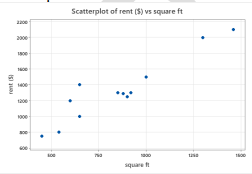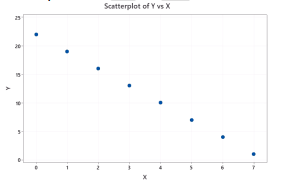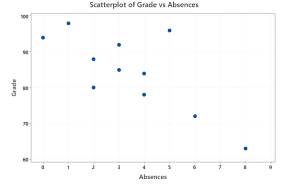Compute the correlation coefficient of a linear model using technology. Interpret the strength and direction of the correlation coefficient.
| Name |
Description |
| Why Correlations? | This lesson is an introductory lesson to correlation coefficients. Students will engage in research prior to the teacher giving any direct instruction. The teacher will provide instruction on how to find the correlation coefficient by hand and using Excel. |
| Why Correlations? | This lesson is an introductory lesson to correlation coefficients. Students will engage in research prior to the teacher giving any direct instruction. The teacher will provide instruction on how to find the correlation coefficient by hand and using Excel. |
| Spreading the Vote Part 3 | Students will explore voter turnout data for three gubernatorial elections before and after the passage of the 19th amendment. They will fit linear functions to the data and compute predicted values for raw and percentage of voter turnout. Students will draw some conclusions concerning the relationship between eligible voters and voter turnout, including possible causes behind the fluctuation in voter participation in this integrated lesson |
| Compacting Cardboard | Students investigate the amount of space that could be saved by flattening cardboard boxes. The analysis includes linear graphs and regression analysis along with discussions of slope and a direct variation phenomenon. |
| A Day at the Park | In this activity, students investigate a set of bivariate data to determine if there is a relationship between concession sales in the park and temperature. Students will construct a scatter plot, model the relationship with a linear function, write the equation of the function, and use it to make predictions about values of variables. |
| Basketball - it's a tall man's sport - or is it? | The students will use NBA player data to determine if there is a correlation between the height of a basketball player and his free throw percentage. The students will use technology to create scatter plots, find the regression line and calculate the correlation coefficient.
Basketball is a tall man's sport in most regards. Shooting, rebounding, blocking shots - the taller player seems to have the advantage. But is that still true when shooting free throws? |
| Heart Rate and Exercise: Is there a correlation? | Students will use supplied heart rate data to determine if heart rate and the amount of time spent exercising each week are correlated. Students will use GeoGebra to create scatter plots and lines of fit for the data and examine the correlation. Students will gather evidence to support or refute statistical statements made about correlation. The lesson provides easy to follow steps for using GeoGebra, a free online application, to generate a correlation coefficient for two given variables. |
| Span the Distance Glider - Correlation Coefficient | This lesson will provide students with an opportunity to collect and analyze bivariate data and use technology to create scatter plots, lines of best fit, and determine the correlation strength of the data being compared. Students will have a hands on inquire based lesson that allows them to create gliders to analyze data. This lesson is an application of skills acquired in a bivariate unit of study. |
| Study of Crowd Ratings at Disney | In this lesson, students develop a strong use of the vocabulary of correlation by investigating crowd ratings at Disney. Students will determine weekly crowd rating regression lines and correlations and discuss what this means for a Disney visit. |
| Hand Me Your Data | Students will gather and use data to calculate a line of fit and the correlation coefficient with their classmates' height and hand size. They will use their line of fit to make approximations. |
| Calculating Residuals and Constructing a Residual Plot with Soccer Seats | Students will learn all about residuals. The definition, how to calculate them, how to plot and analyze residuals, and how to use them to assess the fit of a linear function. They will do this within the context of comparing the location of a seat in a soccer stadium with its price. |
| Why do I have to have a bedtime? | This predict, observe, explain lesson that allows students to make predictions based on prior knowledge, observations, discussions, and calculations. Students will receive the opportunity to express themselves and their ideas while explaining what they learned. Students will make a prediction, collect data, and construct a scatter plot. Next, students will calculate the correlation coefficient and use it to describe the strength and magnitude of a relationship. |
| What's So Funny About Correlation? | Students investigate correlation and causation through the medium of cartoons. Students construct arguments in favor of and against causal relationships between two strongly correlated events and decide which one is more reasonable. Students create cartoons representing the idea that correlation does not imply causation. |
| Scatter Plots and Correlations | Students create scatter plots, and lines of fit, and then calculate the correlation coefficient. Students analyze the results and make predictions. This lesson includes step-by-step directions for calculating the correlation coefficient using Excel, GeoGebra, and a TI-84 Plus graphing calculator. Students will make predictions for the number of views of a video for any given number of weeks on the charts. |
| Scrambled Coefficient | Students will learn how the correlation coefficient is used to determine the strength of relationships among real data. Students use card sorting to order situations from negative to positive correlations. Students will create a scatter plot and use technology to calculate the line of fit and the correlation coefficient. Students will make a prediction and then use the line of fit and the correlation coefficient to confirm or deny their prediction.
Students will learn how to use the Linear Regression feature of a graphing calculator to determine the line of fit and the correlation coefficient.
The lesson includes the guided card sorting task, a formative assessment, and a summative assessment. |
| How technology can make my life easier when graphing | Students will use GeoGebra software to explore the concept of correlation coefficient in graphical images of scatter plots. They will also learn about numerical and qualitative aspects of the correlation coefficient, and then do a matching activity to connect all these representations of the correlation coefficient. They will use an interactive program file in GeoGebra to manipulate the points to create a certain correlation coefficient. Step-by-step instructions are included to create the graph in GeoGebra and calculate the r correlation coefficient. |
| Smarter than a Statistician: Correlations and Causation in the Real World! | Students will learn to distinguish between correlation and causation. They will build their skills by playing two interactive digital games that are included in the lesson. The lesson culminates with a research project that requires students to find and explain the correlation between two real world events. |
| House Hunting! | In this Model Eliciting Activity, MEA, students will analyze and use factors of various counties to recommend the top 3 to buy for a home given a client’s preferences. Students will use weighted averages, key statistics like median and mean, and correlation to conduct a thorough analysis of the data to justify their recommendations.
Model Eliciting Activities, MEAs, are open-ended, interdisciplinary problem-solving activities that are meant to reveal students’ thinking about the concepts embedded in realistic situations. MEAs resemble engineering problems and encourage students to create solutions in the form of mathematical and scientific models. Students work in teams to apply their knowledge of science and mathematics to solve an open-ended problem while considering constraints and tradeoffs. Students integrate their ELA skills into MEAs as they are asked to clearly document their thought processes. MEAs follow a problem-based, student-centered approach to learning, where students are encouraged to grapple with the problem while the teacher acts as a facilitator. To learn more about MEAs visit: https://www.cpalms.org/cpalms/mea.aspx |
| Why Correlations? | This lesson is an introductory lesson to correlation coefficients. Students will engage in research prior to the teacher giving any direct instruction. The teacher will provide instruction on how to find the correlation coefficient by hand and using Excel. |






